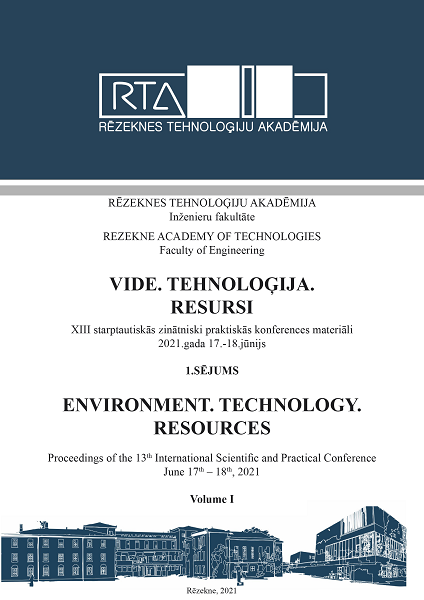CRITICAL THINKING AS GROUNDS OF SOCIALLY RESPONSIBLE COMMUNICATION
DOI:
https://doi.org/10.17770/etr2021vol1.6572Keywords:
Communication, socially responsible communication, critical thinking, critical information processingAbstract
Companies and individuals are willing to introduce the principles of social responsibility in their everyday working practices, still, in order to accomplish this and to have real gains for the company and society, the concept of social responsibility has to be understood in the broadest sense. This understanding is based on critical information processing or critical thinking. Information can be obtained through reflection, observation, communication, experience, etc. The aim of the research is to study the factors that influence the basic principles of critical thinking formation, which are the basis of socially responsible communication. The authors employ the monographic method for charting the theoretical framework, the survey to research respondent’s’ ability to evaluate information critically and to make socially responsible decisions. As the result of research the authors conclude that development of the critical thinking competences can raise the level of social responsibility on the individual and societal level.
Downloads
References
R. L. Johannesen, K. S. Valde and V. E. Whedbee, Ethics in Human Communication. Long Grove, Il.: Waveland Press, Inc., 2008.
Pearson 2013 results. [Online]. Available: https://www.pearson.com/news-and-research/announcements/2014/02/pearson-2013-results.html [Accessed: March 19, 2021].
S. K. W. Chu and others, 21st Century Skills Development Through Inquiry-Based Learning. Singapore: Springer Science+Business Media, 2017.
M. C. Gentile, Giving Voice to Values: How to Speak Your Mind When You Know What’s Right. New Have and London: Yale University Press, 2010.
D. L. Remund, The art of responsible communication. Leading with values every day. New Yourk: Business Expert Press, 2015.
B. Dresp-Langley, “The Communication Contract and Its Ten Ground Clauses,” Journal of Business Ethics, vol. 87, no. 3 2009, pp. 415–436.
S. K. Bandyopadhyay and J. Szostek, „Thinking critically about critical thinking: Assessing critical thinking of business students using multiple measures,” The Journal of Education for Business, vol. 94, no.4, 2018, pp. 1-12, DOI: 10.1080/08832323.2018.1524355
D. F. Halpern, Halpern Critical Thinking Assessment manual. Vienna, Austria: Schuhfried GmbH, 2010.
S. A. Nonis and G. I. Hudson, “Developing and assessing critical thinking skills in marketing students: The power of making explicit problem-solving processes,” Journal of Education for Business, vol. 94, no. 3, 2019, pp. 195-203, https://doi.org/10.1080/08832323.2018.1504737
R. Andrews, “Critical Thinking and/or Argumentation in Higher Education,” in The Palgrave Handbook of Critical Thinking in Higher Education, New York: Palgrave Macmillan, 2015, pp. 49-62.
R. Barnett, “A Curriculum for Critical Being,” in The Palgrave Handbook of Critical Thinking in Higher Education, New York: Palgrave Macmillan, 2015, pp. 63-76.
K. Thomas and B. Lok, “Teaching Critical Thinking: An Operational Framework,” in The Palgrave Handbook of Critical Thinking in Higher Education, New York: Palgrave Macmillan, 2015, pp 93-106.
A. S. Ünsar and E. Engin, “A case study to determine critical thinking skills of university students, “ Procedia - Social and Behavioral Sciences, vol. 75, 2013, pp. 563 – 569, https://doi.org/10.1016/j.sbspro.2013.04.061
M. Karakoc, “The Significance of Critical Thinking Ability in terms of Education, “ International Journal of Humanities and Social Science, vol. 6, no. 7, July 2016, pp. 81-84.
B. Critchley, “Critical Thinking in Business Education,” Investigations in university teaching and learning, vol. 7, spring 2011, 5-15.
A. Khalifa, “Rethinking the Current Dominant Approach to Business School Strategy,” European Business Review, vol. 22, no. 6, 2009, pp. 591-607, https://doi.org/10.1108/09555341011082907
T. Laurer, “Teaching Critical Thinking Skils Using Course Content Material: a reversal of roles,” Journal of College Science Teaching, vol. 34, no. 6, 2005, pp. 34-37.
The Foundation for Critical Thinking. [Online] Available: https://www.criticalthinking.org/pages/defining-critical-thinking/766 [Accessed 20 March, 2021].
T. Bowell and G. Kemp, Critical thinking: A Concise Guide. London and New York: Routledge, 2015.
R. Paul and L. Elder, Critical Thinking Tools for Taking Charge of Your Professional and Personal Life. Upper Saddle River, New Jersey, Pearson Education, Inc., 2014.
F. A. Yusuf and E. A. Adeoye, “Developing Critical Thinking and Communication Skills in Students: Implications for Practice in Education,” African research review, vol. 6, no. 1, 2012, pp. 311-324, http://dx.doi.org/10.4314/afrrev.v6i1.26
H. Hasanah and M. N. Malik, M. N., “Blended learning in improving students’ critical thinking and communication skills at University,” Cypriot Journal of Educational Science, vol. 15, no. 5, 2020, pp. 1295 - 1306, https://doi.org/10.18844/cjes.v15i5.5168
I. Arhipova and S. Bāliņa, Statistics in Economy and Business [Statistika ekonomikā un biznesā]. Riga: Datorzinību centrs, 2006.
S. L. Payne, The Art of Asking Questions. Princeton: Princeton University Press, 1978.
P. L. Erdos, Professional Mail Surveys. Melburne, Fla.: Robert E.Krieger Publishing, 1983.


